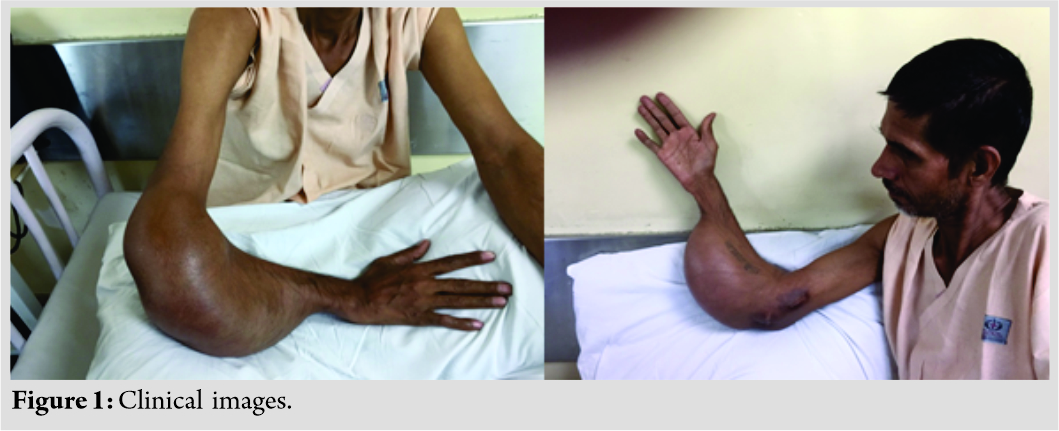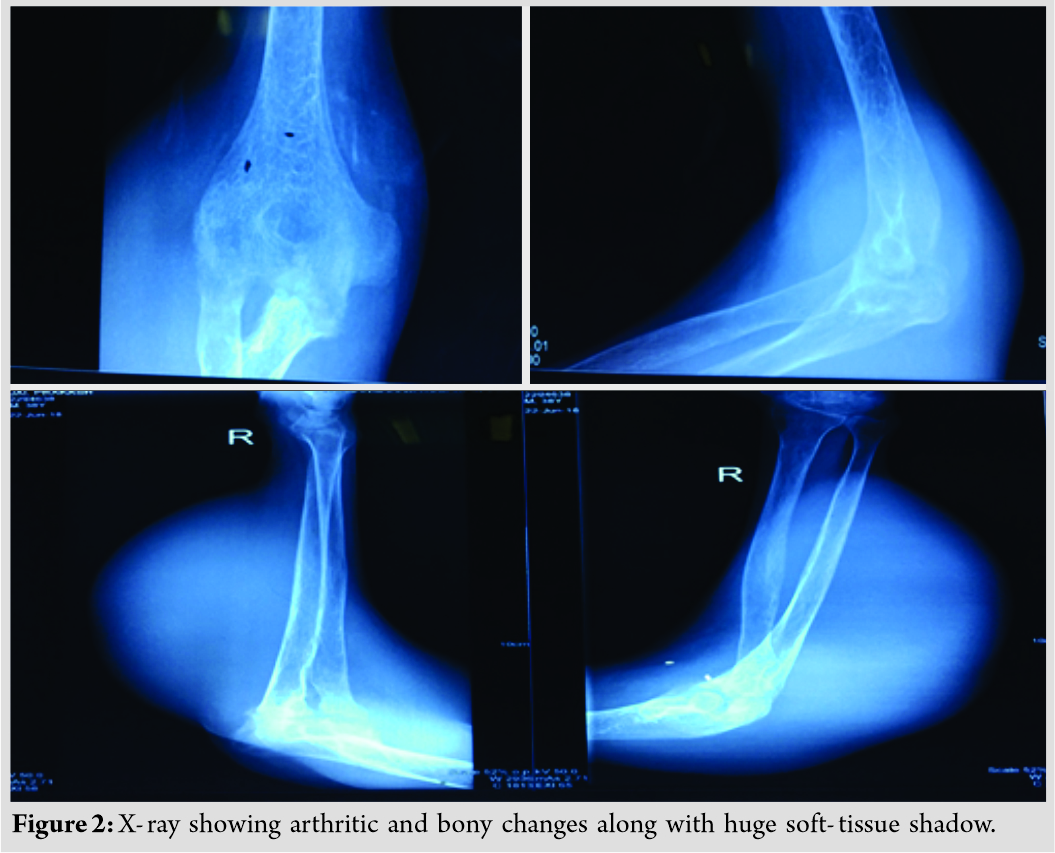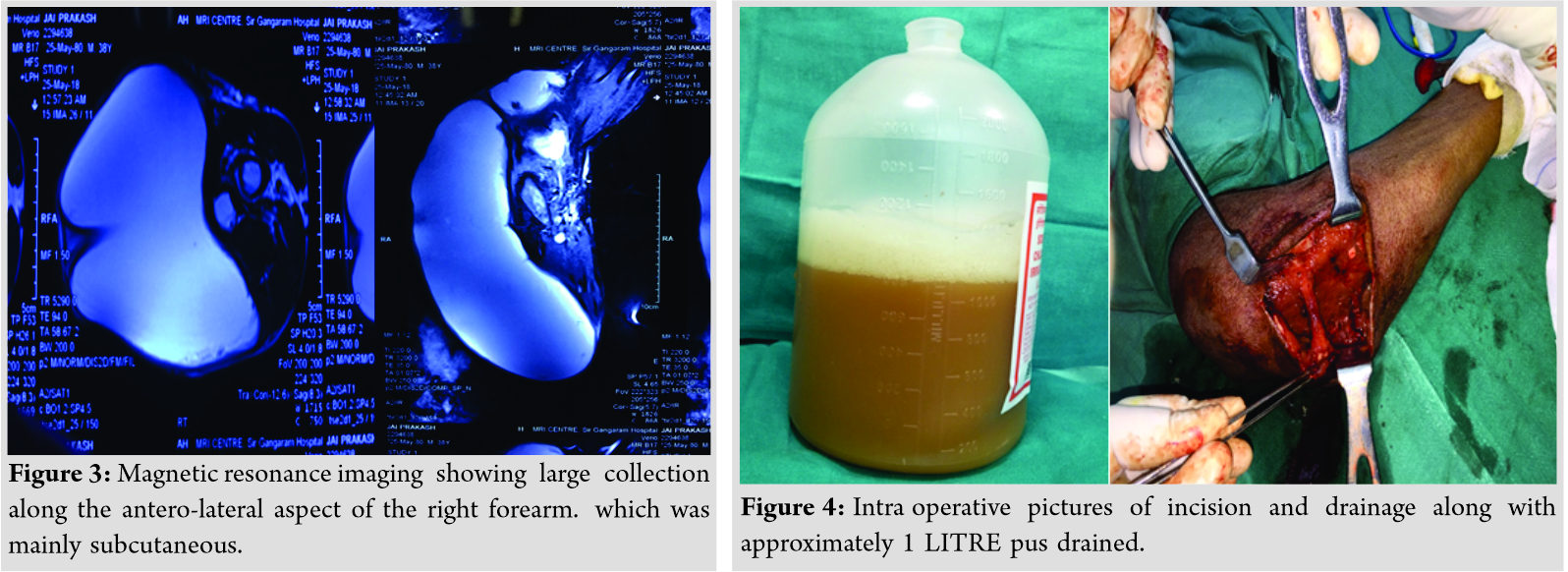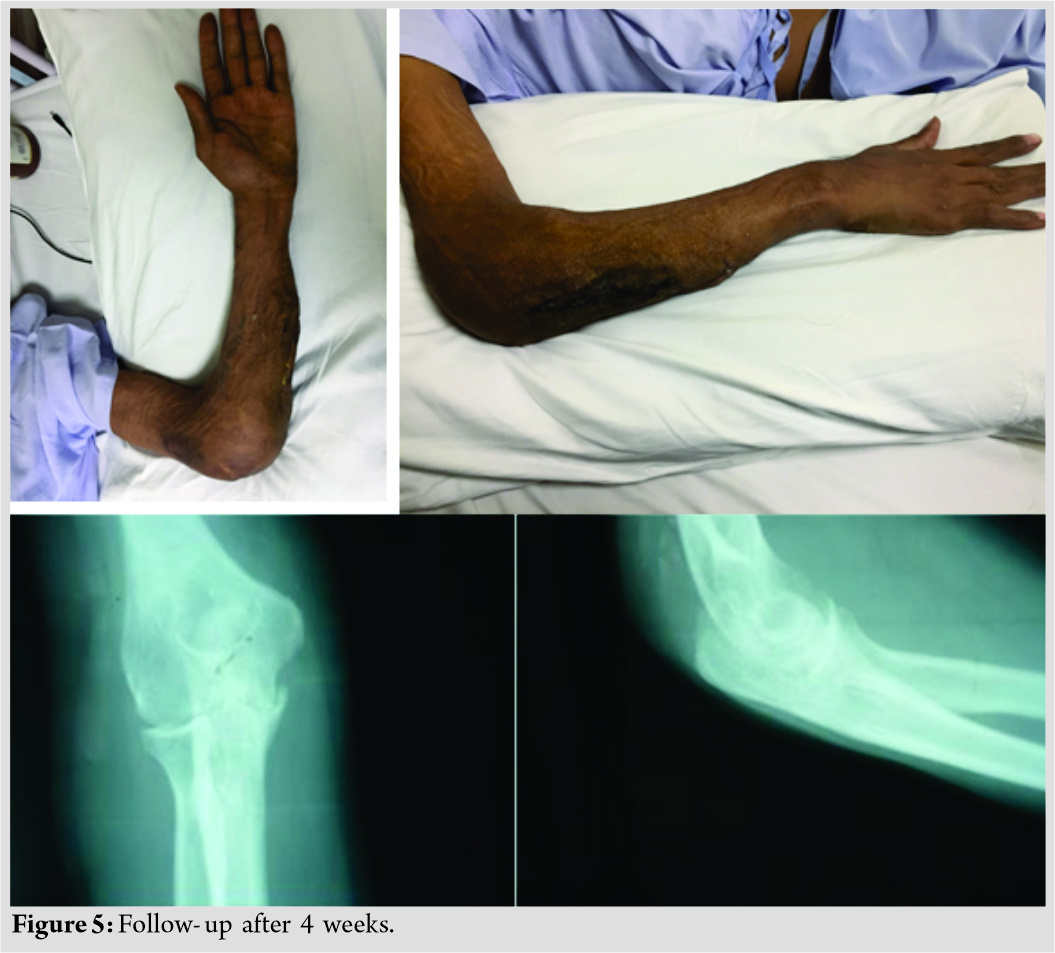[box type=”bio”] Learning Point of the Article: [/box]
Any softtissue swelling adjacent to a joint, a thorough evaluation to rule out osteoarticular tuberculosis is highly recommended.
Case Report | Volume 10 | Issue 5 | JOCR August 2020 | Page 5-8| Siddharth Agrawal, Sijal Rivi, Ravi Chauhan, Brajesh Nandan, Manish Dhawan, Prasanna Deshpande. DOI: 10.13107/jocr.2020.v10.i05.1812
Authors: Siddharth Agrawal[1], Sijal Rivi[1], Ravi Chauhan[1], Brajesh Nandan[1], Manish Dhawan[1], Prasanna Deshpande[1]
[1]Department of Orthopaedic Surgery, Sir Gangaram Hospital, New Delhi, India.
Address of Correspondence:
Dr. Ravi Chauhan,
Department of Orthopaedic Surgery, Department of Orthopaedic Surgery, Sir Gangaram Hospital, New Delhi, India.
E-mail: dr.ravichauhan15@gmail.com
Abstract
Introduction: Mycobacterial infection of the upper extremities is rare with elbow joint being most frequently affected accounting for 2– to 5 % of all skeletal localizations. Diagnosis is of paramount importance in tuberculosis of elbow because delay in analysis could prime to serious difficulties.
Case Presentation: We describe a rare presentation of a 38- year- old male with tuberculosis of elbow joint. Massive swelling of forearm with subcutaneous collection without any significant involvement of forearm muscles has rarely been reported. This case will be a significant addition to literature with respect to clinical presentation of elbow tuberculosis.
Conclusion: Tuberculosis of elbow along with that of a forearm is rare and surgical intervention can lead to better outcomes in these patients.
Keywords: Tuberculosis, elbow, forearm.
Introduction
Musculoskeletal tuberculosis has been showing a resurgence in the past few years due to the increased number of immunocompromised individual and emergence of drug-resistant bacteria [1]. Musculoskeletal system is involved in 1–3% of patients with tuberculosis and accounts for 10% of all extra-pulmonary tuberculosis with the common sites being the spine (51%), pelvis (12%), hip and femur (10%), knee and tibia (10%), and ribs (7%). Mycobacterial disease of the upper extremities is rare with elbow joint most frequently acted on, accounting for 2–5% of all skeletal location [1, 2, 3]. Diagnosing is of most importance in osteoarticular T.B. as a result of delay in diagnosing will cause serious complications. In spite of wide organized row of investigations accessible for tuberculosis, the importance of history and clinical examination of the patient cannot be interfered with, however, clinical presentation is not very common sometimes like this in a 38-year-old male with huge forearm swelling. We are reporting this case to highlight the clinical presentation of tuberculosis of elbow and forearm with an aim of adding something new in the literature.
Case presentation
A male of a 38-year-old presented to us with pain complaints and swelling in his right elbow and forearm for the past 1 year. Pain was insidious in onset, moderate in intensity, non-radiating, gradually progressive in nature, aggravated by movement, partially relieved with rest. Initially, the swelling was localized to elbow joint extending to forearm on the past few months. No history of weight loss was there and any history of trauma but was associated with episodes of fever. On examination, the patient appeared malnourished, locally massive swelling extending from elbow to distal forearm was seen. Swelling was circumferential around the elbow joint, distally it was localized to anterolateral aspect of forearm. It was tense, with prominent veins, and was tender around the elbow but non-tender around forearm. It was soft and cystic in consistency, compressible, with positive fluctuation. Movements around elbow joints were limited (Fig. 1). 



Discussion
“Non-weight-bearing joints affected by tuberculosis, elbow joint being the most frequently involved joint in the upper extremity followed by shoulder joint” [1, 2]. “Mycobacterium tuberculosis is the main causative organism with only few cases attributable to Mycobacterium bovis and atypical Mycobacterium” [4]. “Osteoarticular tuberculosis is the result of blood, lymphatic, or local contamination from adjacent or other areas of primary infection with rare cases from direct inoculation of bacteria” [5]. Pathogenesis of elbow joint tuberculosis involves reactive hyperemia resulting in marked juxta-articular bone demineralization, local bone destruction, periosteal new bone formation, and forearm involvement ranging from involvement of subcutaneous plane or forearm muscles. Infection starts as synovitis causing joint effusion erosions and destruction of bone and cartilage. When untreated para-articular soft tissue are also involved. This involvement may confine to muscles or rarely to subcutaneous tissue. Clinically, the diagnosis of osteoarticular tuberculosis is difficult with gradual onset of joint pain, swelling, decreased range of motion progressive loss of function, and deformity. During the early phase, tuberculous osteoarthritis might be quickly mistaken for trauma, septic, or rheumatoid osteoarthritis. “Osteoarticular TB should be suspected in patients of South Asian and African origin presenting with bony and soft-tissue infective lesions” [6]. Even though in most instances, biopsy or maybe culture specimen is forced to create the conclusive analysis, it is critical that “Radiologists and clinicians understand the typical distribution, patterns, and imaging manifestations of musculoskeletal tuberculosis” [7]. In the Indian subcontinent, the presentation of elbow tuberculosis is usually exudative with abscess formation and the disease is fairly advanced at the time of diagnosis as in our case. Delay in diagnosis can lead result in problems of irreversible osteodestruction and septic osteoarthritis. In our case, the elbow swelling was mastered by the forearm swelling and was mistaken as some tumor. Changes in plain film radiography of the affected joint included periarticular osteoporosis, peripherally located osseous erosions and gradual narrowing of the cartilage space known as Phemister triad. Round or oval lesions with poorly defined margins in bone adjacent to the affected joint with joint effusion and soft-tissue swelling are a common finding in extremity tuberculosis, as in our patient. MRI features include bone marrow changes indicating osteomyelitis or bone marrow edema, bone erosions, synovial thickening, and joint effusion. Synovial thickening associated with osteoarticular tuberculosis is hypointense on T2-weighted MRI images, distinguishing this from other proliferating synovial arthropathies. Radiological findings in osteoarticular tuberculosis are non-specific and require aspiration or synovial biopsy for definitive diagnosis. Cultures and synovial microscopy yield positive results in up to 80% of individuals with osteoarticular tuberculosis while residual is identified through complete synovial or even biopsies of bone. Histology displays caseating granulomas though a Ziehl-Nielsen stain is negative. The surgical intervention could appreciably alter the outcome, especially in patients with extra-articular involvement close to the joint. Massive swelling of forearm with subcutaneous collection without any significant involvement of forearm muscles has rarely been reported. This case will be a significant addition to literature with respect to clinical presentation of elbow tuberculosis as similar studies by Protzman et al., [8] Yazici et al. [9] prescribed a fairly conservative approach with just the conservative management we recommend if the swelling is massive or unusual extending to arm or forearm, surgical intervention is a better option.
Conclusion
Although extra-articular involvement in elbow tuberculosis is rare, in unusual presentation of forearm swelling, this has to be kept in mind and that surgical intervention can lead to better outcomes in these patients.
Clinical Message
Extra-articular tuberculosis is a rare entity still any soft-tissue swelling adjacent to a joint, a thorough clinical and radiological evaluation to rule out osteoarticular tuberculosis should be done.
References
1. Aggarwal A, Dhammi I. Clinical and radiological presentation of tuberculosis of the elbow. Acta Orthop Belg 2006;72:282-7.
2. Sdillon M, Goel A, Prabhakar S, Aggarwal S, Bachhal V. Tuberculosis of the elbow: A clinicoradiological analysis. Indian J Orthop 2012;46:200-5.
3. Tuli SM. Tuberculosis of the Skeletal System. 2nd ed. New Delhi: Jaypee Brothers; 1997. p. 132-40.
4. Sagoo RS, Lakdawala A, Subbu R. Tuberculosis of the elbow joint. JRSM Short Rep 2011;2:17.
5. Lupatkin H, Brau N, Flomenbergh P, Simberkoff MS. Tuberculosis abscesses in patients with AIDS. Clin Infect Dis 1992;14:1040-4.
6. Agarwal A, Mumtaz I, Kumar P, Khan S, Qureshi NA. Tuberculosis of the elbow joint in children: A review of ten patients who were managed nonoperatively. J Bone Joint Surg Am 2010;92:436-41.
7. Burrill J, Williams CJ, Bain G, Conder G, Hine AL, Misra RR. Tuberculosis: A radiologic review. Radiographics 2007;27:1255-73.
8. Protzman N, Busch M, Kannangara S, Novatnack E. Elbow Mycobacterium tuberculosis in America. J Glob Infect Dis 2015;7:44-5.
9. Yazici A, Kayan G, Yaylaci S, Demir MV, Karakeçe E, Tamer A, et al. Tuberculous arthritis of the elbow joint: A case report. Eur J Rheumatol 2016;3:142-3.
 |
 |
 |
 |
 |
| Dr. Siddharth Agrawal | Dr. Sijal Rivi | Dr. Ravi Chauhan | Dr. Brajesh Nandan | Dr. Manish Dhawan |
| How to Cite This Article: Agrawal S, Rivi S, Chauhan R, Nandan B, Dhawan M, Deshpande P. An Unusual Case of Swelling of Tuberculosis of Elbow and Forearm : A Case Report. Journal of Orthopaedic Case Reports 2020 August;10(5): 5-8 |
[Full Text HTML] [Full Text PDF] [XML]
[rate_this_page]
Dear Reader, We are very excited about New Features in JOCR. Please do let us know what you think by Clicking on the Sliding “Feedback Form” button on the <<< left of the page or sending a mail to us at editor.jocr@gmail.com




